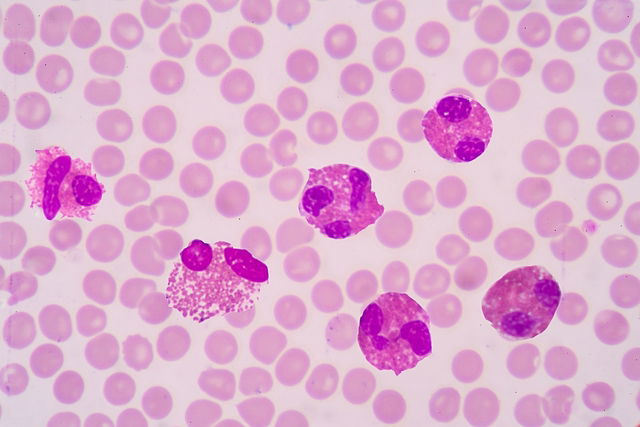Eosinophils are a type of defense cell in the blood that come from the differentiation of a bone marrow cells, a myeloblast. Its purpose is to defend the body against invader microorganisms. They play an essential role in the immune system.
High eosinophils may be a sign of an allergic reaction or a parasitic, bacterial or fungal infection, On the other hand, eosinophils can become lower in the acute phase of a bacterial infection, after surgery or after using corticosteroids.
Compared to other defense cells, like lymphocytes, monocytes and neutrophils, eosinophils circulate at a lower overall concentration.

Reference ranges
Eosinophil levels are evaluated through the CBC (complete blood count) from a blood test. The CBC looks includes testing of all white blood cells in the blood sample. Normal eosinophil levels are:
- Absolute value: 20 to 500 cells/ µL of blood - this is the total level of eosinophils in the blood
- Relative value: 1 to 6% - this is the percentage of eosinophils in relation to other white blood cells
Reference values can vary from lab to lab, and results should be evaluated by the family doctor. All testing should be interpreted together to determine the underlying cause.
High eosinophils
High eosinophil levels, also known as eosinophilia, occurs when there are over 500 eosinophils per microliter of blood. High levels can occur for many reasons, such as:
- Allergies, like asthma, hives, allergic rhinitis, dermatitis, eczema
- Worm infections, like ascaridiasis, toxocariasis, hookworm, oxyuriasis, schistosomiasis, among others
- Viral infections, like typhoid fever, tuberculosis, aspergillosis, coccidioidomycosis, and some viruses
- Allergies to medication, like aspirin, antibiotics, anti-hypertensives or tryptophan, for example
- Inflammatory skin diseases, such as bullous pemphigus, dermatitis
- Other inflammatory diseases, like inflammatory bowel syndrome, hematologic disorder, cancer or other genetic illnesses that cause hereditary eosinophilia
In some rare cases, it is still possible not to know what exactly caused the high eosinophils. This is referred to as idiopathic eosinophilia. There is also a condition known as hypereosinophilia, which is when the eosinophil count is very high and exceeds 10,000 cells/µL. This is more common in autoimmune and genetic diseases, such as hypereosinophilic syndrome.
Eosinophilia itself does not cause signs or symptoms, but it is possible for patients with high levels to experience shortness of breath, sneezing, nasal congestion, itchy skin, fever , body pain, diarrhea or abdominal pain, for example.
Low eosinophils
Low eosinophils in the blood, also known as eosinopenia, occurs when eosinophils are below 20 eosinophils per microliter of blood.
Eosinopenia can occur with acute bacterial infections (such as pneumonia or meningitis), as these types of infections that usually increase all defense cells in the blood, such as neutrophils. This can decrease the absolute or relative count of eosinophils.
Decreased eosinophils can also be a result of decreased immunity due to illness or the use of medications that alter the function of the immune system, such as corticosteroids. In addition, eosinopenia can be a consequence of pernicious anemia, burns, Cushing's syndrome, seizures or surgeries.
